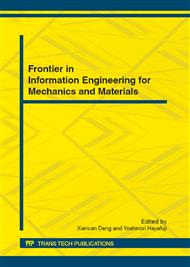p.265
p.270
p.274
p.281
p.285
p.290
p.295
p.300
p.306
Analysis of a Novel SAW Acceleration Sensor with Cantilever Beam Using ST-X Quartz
Abstract:
In order to improve the signal-noise rate (SNR) of the acceleration sensor system, this article analysis of the design principles of a novel surface acoustic wave (SAW) acceleration sensor with cantilever beam using ST-X quartz. The main structure of the novel SAW acceleration sensor is composed of two oscillator, a mixer and a low pass filter to get the difference frequency structure, which can inhibit temperature drift and lateral acceleration impact. The two oscillator have the same structure, which is constitute of a low insertion loss SAW delay line and a feedback amplifier. This article shows the simulation results of the force analysis of the cantilever beam free end using ANSYS finite element analysis software. The novel acceleration sensor has potential applications in portable mobile devices or automotive airbags fields.
Info:
Periodical:
Pages:
285-289
Citation:
Online since:
July 2012
Authors:
Price:
Сopyright:
© 2012 Trans Tech Publications Ltd. All Rights Reserved
Share:
Citation:


